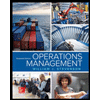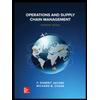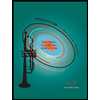Hart Manufacturing makes three products. Each product requires manufacturing operations in three departments: A, B, and C. The labor-hour requirements, by department, are as follows. Department Product 1 s.t. A B C 1.50 2.00 0.25 Product 2 Product 3 3.00 1.00 0.25 2.00 ✓ 2.50 During the next production period, the labor-hours available are 450 in department A, 350 in department B, and 50 in department C. The profit contributions per unit are $25 for product 1, $27 for product 2, and $28 for product 3. (a) Formulate a linear programming model for maximizing total profit contribution. (Let P, = units of product i produced, for i = 1, 2, 3.) Max 25P₁ +27P2+28P3 0.25 Department A 1.50P₁ +3.00P2 +2.00P3 ≤450 Department B 2.00P₁ +1.00P₂ +2.50P ≤350 2 Department c 0.25P₁+0.25P₂ +0.25P3 ≤ 50 P₁, P₂, P3 20 (b) Solve the linear program formulated in part (a). How much of each product should be produced, and what is the projected total profit contribution (in dollars)? (P1, P2, P3): 60,80,60 with profit $ 5340 (c) After evaluating the solution obtained in part (b), one of the production supervisors noted that production setup costs had not been taken into account. She noted that setup costs are $400 for product 1, $590 for product 2, and $610 for product 3. If the solution developed in part (b) is to be used, what is the total profit contribution (in dollars) after taking into account the setup costs? $ 3740
Hart Manufacturing makes three products. Each product requires manufacturing operations in three departments: A, B, and C. The labor-hour requirements, by department, are as follows. Department Product 1 s.t. A B C 1.50 2.00 0.25 Product 2 Product 3 3.00 1.00 0.25 2.00 ✓ 2.50 During the next production period, the labor-hours available are 450 in department A, 350 in department B, and 50 in department C. The profit contributions per unit are $25 for product 1, $27 for product 2, and $28 for product 3. (a) Formulate a linear programming model for maximizing total profit contribution. (Let P, = units of product i produced, for i = 1, 2, 3.) Max 25P₁ +27P2+28P3 0.25 Department A 1.50P₁ +3.00P2 +2.00P3 ≤450 Department B 2.00P₁ +1.00P₂ +2.50P ≤350 2 Department c 0.25P₁+0.25P₂ +0.25P3 ≤ 50 P₁, P₂, P3 20 (b) Solve the linear program formulated in part (a). How much of each product should be produced, and what is the projected total profit contribution (in dollars)? (P1, P2, P3): 60,80,60 with profit $ 5340 (c) After evaluating the solution obtained in part (b), one of the production supervisors noted that production setup costs had not been taken into account. She noted that setup costs are $400 for product 1, $590 for product 2, and $610 for product 3. If the solution developed in part (b) is to be used, what is the total profit contribution (in dollars) after taking into account the setup costs? $ 3740
Practical Management Science
6th Edition
ISBN:9781337406659
Author:WINSTON, Wayne L.
Publisher:WINSTON, Wayne L.
Chapter2: Introduction To Spreadsheet Modeling
Section: Chapter Questions
Problem 20P: Julie James is opening a lemonade stand. She believes the fixed cost per week of running the stand...
Related questions
Question
I just need clear solutions and answers for part D and part E please
![### Linear Programming Example: Hart Manufacturing
**Objective:**
Hart Manufacturing produces three products. Each requires operations in three departments: A, B, and C. The labor-hour requirements per department are listed below:
| Department | Product 1 | Product 2 | Product 3 |
|------------|-----------|-----------|-----------|
| A | 1.50 | 3.00 | 2.00 |
| B | 2.00 | 1.00 | 2.50 |
| C | 0.25 | 0.25 | 0.25 |
The available labor-hours for the next production period are: 450 for Department A, 350 for Department B, and 50 for Department C. Profit contributions per unit are $25 for Product 1, $27 for Product 2, and $28 for Product 3.
#### (a) Formulate a Linear Programming Model
Maximize:
\[ 25P_1 + 27P_2 + 28P_3 \]
Subject to:
- Department A: \[ 1.50P_1 + 3.00P_2 + 2.00P_3 \leq 450 \]
- Department B: \[ 2.00P_1 + 1.00P_2 + 2.50P_3 \leq 350 \]
- Department C: \[ 0.25P_1 + 0.25P_2 + 0.25P_3 \leq 50 \]
Where:
- \( P_1, P_2, P_3 \geq 0 \) (Units of each product)
#### (b) Solution to the Linear Program
Optimal production quantities:
\[ (P_1, P_2, P_3) = (60, 80, 60) \]
Maximum profit: \[ \$5340 \]
#### (c) Adjusted Profit with Setup Costs
Setup costs:
- Product 1: \$400
- Product 2: \$590
- Product 3: \$610
Total profit after setup costs: \[ \$3740 \]
### Conclusion
Hart Manufacturing can achieve a maximum profit contribution of \$5340 by producing 60 units of Product 1, 80 units of Product 2, and 60](/v2/_next/image?url=https%3A%2F%2Fcontent.bartleby.com%2Fqna-images%2Fquestion%2Feeaa8045-e0ae-4f8f-bfb9-81e4f69114f4%2Fd336190a-3ec3-4958-bc3c-e744b3d105cb%2Fix2j3k_processed.png&w=3840&q=75)
Transcribed Image Text:### Linear Programming Example: Hart Manufacturing
**Objective:**
Hart Manufacturing produces three products. Each requires operations in three departments: A, B, and C. The labor-hour requirements per department are listed below:
| Department | Product 1 | Product 2 | Product 3 |
|------------|-----------|-----------|-----------|
| A | 1.50 | 3.00 | 2.00 |
| B | 2.00 | 1.00 | 2.50 |
| C | 0.25 | 0.25 | 0.25 |
The available labor-hours for the next production period are: 450 for Department A, 350 for Department B, and 50 for Department C. Profit contributions per unit are $25 for Product 1, $27 for Product 2, and $28 for Product 3.
#### (a) Formulate a Linear Programming Model
Maximize:
\[ 25P_1 + 27P_2 + 28P_3 \]
Subject to:
- Department A: \[ 1.50P_1 + 3.00P_2 + 2.00P_3 \leq 450 \]
- Department B: \[ 2.00P_1 + 1.00P_2 + 2.50P_3 \leq 350 \]
- Department C: \[ 0.25P_1 + 0.25P_2 + 0.25P_3 \leq 50 \]
Where:
- \( P_1, P_2, P_3 \geq 0 \) (Units of each product)
#### (b) Solution to the Linear Program
Optimal production quantities:
\[ (P_1, P_2, P_3) = (60, 80, 60) \]
Maximum profit: \[ \$5340 \]
#### (c) Adjusted Profit with Setup Costs
Setup costs:
- Product 1: \$400
- Product 2: \$590
- Product 3: \$610
Total profit after setup costs: \[ \$3740 \]
### Conclusion
Hart Manufacturing can achieve a maximum profit contribution of \$5340 by producing 60 units of Product 1, 80 units of Product 2, and 60
![(d) Management realized that the optimal product mix, taking setup costs into account, might be different from the one recommended in part (b). Formulate a mixed-integer linear program that takes setup costs into account. Management also stated that we should not consider making more than 145 units of product 1, 175 units of product 2, or 190 units of product 3. (Let \( P_i = \) units of product \( i \) produced and \( y_i \) be the 0-1 variable that is one if any quantity of product \( i \) is produced and zero otherwise, for \( i = 1, 2, 3 \).
What is the objective function of the mixed-integer linear program?
Max \[ 25P_1 + 27P_2 + 28P_3 - 400y_1 - 590y_2 - 610y_3 \] ✔️
In addition to the constraints from part (a), what other constraints should be added to the mixed-integer linear program?
s.t.
units of Product 1 produced \[ P_1 - 145y_1 = 0 \] ❌
units of Product 2 produced \[ P_2 - 175y_2 = 0 \] ❌
units of Product 3 produced \[ P_3 - 190y_3 = 0 \] ❌
\[ P_1, P_2, P_3 \geq 0; \; y_1, y_2, y_3 = 0, 1 \]
(e) Solve the mixed-integer linear program formulated in part (d). How much of each product should be produced, and what is the projected total profit (in dollars) contribution?
\[ (P_1, P_2, P_3, y_1, y_2, y_3) = (145, 0, 0, 1, 0, 0) \] with profit \($\) \[ 3225 \] ❌.](/v2/_next/image?url=https%3A%2F%2Fcontent.bartleby.com%2Fqna-images%2Fquestion%2Feeaa8045-e0ae-4f8f-bfb9-81e4f69114f4%2Fd336190a-3ec3-4958-bc3c-e744b3d105cb%2Fx68j3wf_processed.png&w=3840&q=75)
Transcribed Image Text:(d) Management realized that the optimal product mix, taking setup costs into account, might be different from the one recommended in part (b). Formulate a mixed-integer linear program that takes setup costs into account. Management also stated that we should not consider making more than 145 units of product 1, 175 units of product 2, or 190 units of product 3. (Let \( P_i = \) units of product \( i \) produced and \( y_i \) be the 0-1 variable that is one if any quantity of product \( i \) is produced and zero otherwise, for \( i = 1, 2, 3 \).
What is the objective function of the mixed-integer linear program?
Max \[ 25P_1 + 27P_2 + 28P_3 - 400y_1 - 590y_2 - 610y_3 \] ✔️
In addition to the constraints from part (a), what other constraints should be added to the mixed-integer linear program?
s.t.
units of Product 1 produced \[ P_1 - 145y_1 = 0 \] ❌
units of Product 2 produced \[ P_2 - 175y_2 = 0 \] ❌
units of Product 3 produced \[ P_3 - 190y_3 = 0 \] ❌
\[ P_1, P_2, P_3 \geq 0; \; y_1, y_2, y_3 = 0, 1 \]
(e) Solve the mixed-integer linear program formulated in part (d). How much of each product should be produced, and what is the projected total profit (in dollars) contribution?
\[ (P_1, P_2, P_3, y_1, y_2, y_3) = (145, 0, 0, 1, 0, 0) \] with profit \($\) \[ 3225 \] ❌.
Expert Solution
This question has been solved!
Explore an expertly crafted, step-by-step solution for a thorough understanding of key concepts.
This is a popular solution!
Trending now
This is a popular solution!
Step by step
Solved in 3 steps with 4 images

Recommended textbooks for you

Practical Management Science
Operations Management
ISBN:
9781337406659
Author:
WINSTON, Wayne L.
Publisher:
Cengage,

Operations Management
Operations Management
ISBN:
9781259667473
Author:
William J Stevenson
Publisher:
McGraw-Hill Education

Operations and Supply Chain Management (Mcgraw-hi…
Operations Management
ISBN:
9781259666100
Author:
F. Robert Jacobs, Richard B Chase
Publisher:
McGraw-Hill Education

Practical Management Science
Operations Management
ISBN:
9781337406659
Author:
WINSTON, Wayne L.
Publisher:
Cengage,

Operations Management
Operations Management
ISBN:
9781259667473
Author:
William J Stevenson
Publisher:
McGraw-Hill Education

Operations and Supply Chain Management (Mcgraw-hi…
Operations Management
ISBN:
9781259666100
Author:
F. Robert Jacobs, Richard B Chase
Publisher:
McGraw-Hill Education


Purchasing and Supply Chain Management
Operations Management
ISBN:
9781285869681
Author:
Robert M. Monczka, Robert B. Handfield, Larry C. Giunipero, James L. Patterson
Publisher:
Cengage Learning

Production and Operations Analysis, Seventh Editi…
Operations Management
ISBN:
9781478623069
Author:
Steven Nahmias, Tava Lennon Olsen
Publisher:
Waveland Press, Inc.